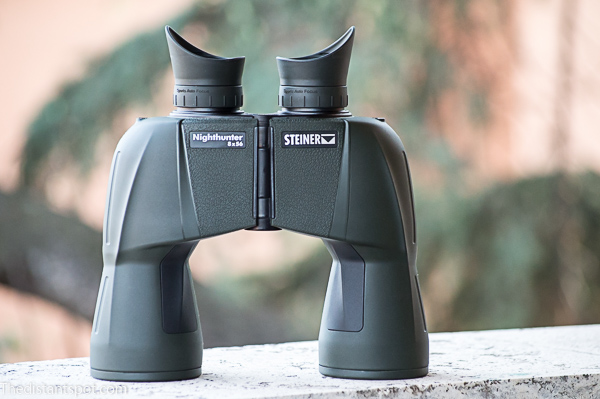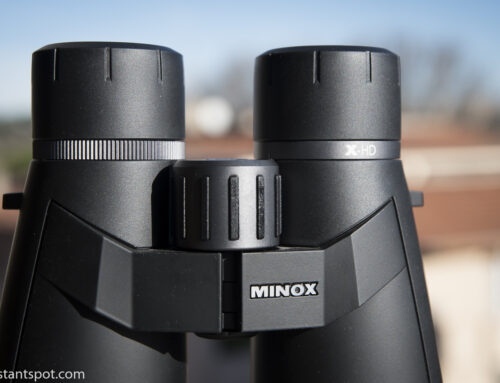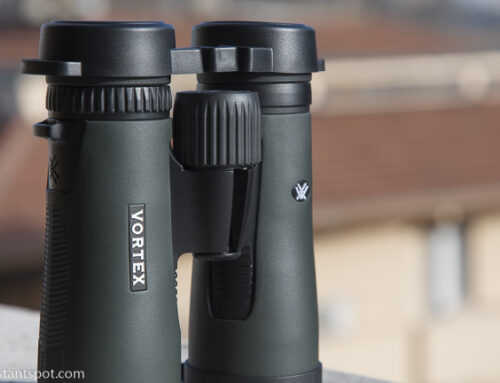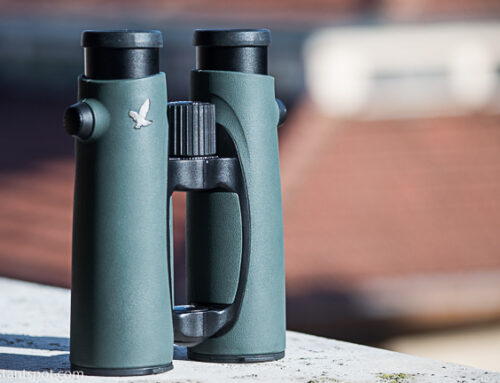Steiner Nighthunter 8×56
Intro
There is a word that can summarize the essence of the Steiner Nighthunter 8×56: huge.
They are large and solid binoculars, certainly the largest I’ve ever held.
Construction
They are built like a tank and give an incredible sense of solidity even just looking at them.
When you pick them up, you can appreciate the high quality of the rubber coating, which is soft without being sticky and which completely covers the structure of the binoculars.
Two shaped lines run on the tubes and allow the fingers to rest comfortably.
Despite being quite heavy binoculars (just over a kilo) the weight is well distributed and the possibility to hold them with great comfort makes them appear lighter than they are.
The eyecups are shaped so as to accompany the profile of the face and block any light coming from the side.
Although they do their job very well, the shells completely block the circulation of air around the eyes, causing an unpleasant sensation of heat which, at least in summer, makes it very hard to use for more than a few moments.
Anyway the eyecups can be rolled up easily so as not to disturb. I do not know how long the rubber will be able to resist, but it looks very sturdy.
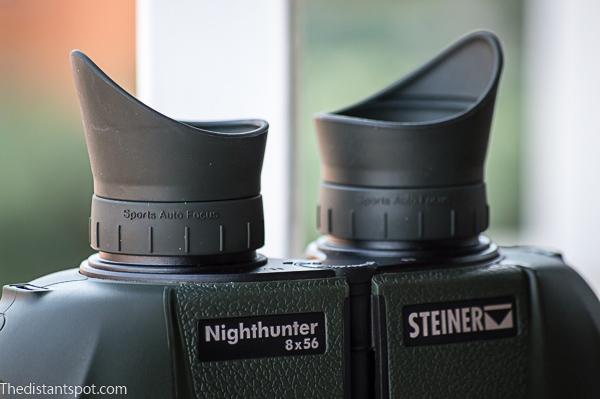
Sports-Auto-Focus
Steiner claims to have a special focus system, called “sports-auto-focus”. In fact, that simply means “individual focus”: each eyepiece must be focused individually by turning a knob that is directly on the eyepiece itself. There is no central focusing knob.
Setting the focus on a subject far away (over 15 meters, I would say) gives a correct focus from there to infinity, without the need for further modifications.
I had never had experience with such a focusing system and I can say, without doubts, that I hate it.
I don’t have perfect eyesight, but I don’t usually wear glasses.
Most binoculars allow you to compensate for the differences in visual acuity between the two eyes so that you can achieve a uniform vision with both. Once you have adjusted the compensation of a single eyepiece, you can focus correctly by simply turning the focusing knob as usual.
This is an uncomfortable and often cumbersome operation, but it is only done once.
In case your visual defect, as it happens for me, is similar in both eyes, it is not even necessary to compensate: with respect to a subject with normal vision, you only need to vary the focus.
Having to individually focus both eyepieces makes this solution impossible.
Each eyepiece must be adjusted independently and, if you are sharing your binoculars with someone else, both focusing knobs must be returned to their initial position before they can see clearly.
At that point, correcting the focus again will require a series of strenuous attempts, unless you have noted the position of the eyepieces that works for you.
The notches on the focusing ring of the Steiner Nighthunter 8×56 can be used for this purpose, but only if it is not too dark to see them. Unfortunately, since these binoculars are specifically suited for use in the dark, it is quite probable that you will find yourself in the last situation.
The single focus offers a number of advantages in terms of resistance and waterproofness of the binoculars, but, unless you have a completely correct vision, these advantages come with a great sacrifice.
The difficulty of reaching a correct focus with both eyes has meant that, during my test, I carefully avoided varying the focus, preferring to observe objects out of focus rather than repeating the procedure.
Furthermore, the knobs are very resistant and adjusting the focus is quite difficult.
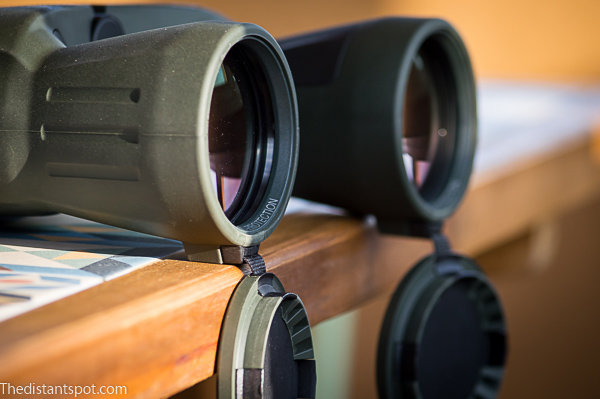
Lens cap covers
The lens caps are fantastic. They are certainly the best I’ve ever seen. They are made of thick rubber and sturdy plastic, and they attach directly to the tubes, without the need to held them in place with rubber rings. Once on, they fit perfectly inside the tubes with a closure that is very clean.
Unlike other models, which are also much more expensive (including my Swarovski EL 8.5×42 W B), the joints between the cap and the coupling to the tubes are not made of rubber, like the rest of the caps, but with two strips of fabric that make them much more flexible and, presumably, more durable.
I have always wondered how long it will take before the rubber caps of my Swarovski give up: in this case, I believe that there will be no failure.
Optical qualities
From an optical standpoint, the Steiner Nighthunter 8×56 fail to match their excellent mechanical and constructive performance.
To evaluate these aspects, I compared them with two other binoculars. Since I don’t have another comparable pair of 8×56 binoculars, I compared them with a Swarovski EL 8.5×42 and with a Kowa BD 8×32 Prominar XD, both excellent binoculars in their categories.
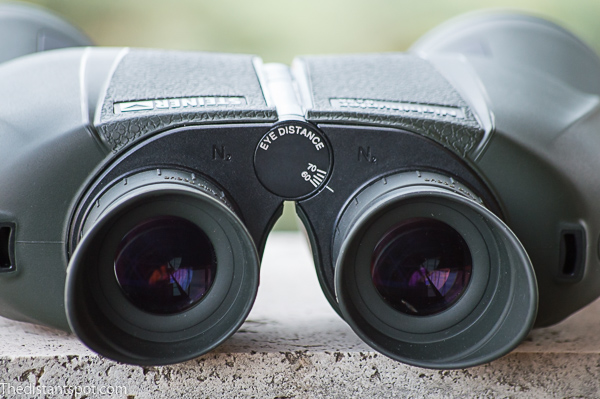
Chromatic aberration
The chromatic aberration is very evident already in the center of the field. The swallows, observed in the afternoon against the background of a fairly covered sky, were surrounded by a showy halo: purple in the upper part, green in the lower part. A purple outline also decorated the top of a lamppost exactly in the center of the image.
Even if the chromatic aberration increases towards the edge, it never becomes much more evident than it is already in the center of the field.
Sharpness
The sharpness is excellent in the center of the field, but it begins to fall as soon as you move: even a minimum movement produces a drop in sharpness that, if by day, framing a panorama, can pass unnoticed, is evident at night, observing the moon.
However, up to 50% from the edge the sharpness remains good, then it starts to deteriorate more markedly but, up to 75/80%, it still remains acceptable and, even on the edge, it doesn’t become terrible. The sharpness seems to get worse more quickly by moving the object framed along the vertical axis, while staying higher in the case of horizontal movement.
The three binoculars are all very sharp: the Kowa are almost like the other two, while Swarovski and Steiner are very close.
To be honest, I must admit that the Steiner are more contrasted, either in the observation of the moon, in which you can perceive a greater chromatic separation between the seas and the other lighter areas, and in the observation of a group of trees in the distance: the details of their barks seem to stand out more.
Astigmatism
The binoculars have a very low astigmatism, similar to that of the Kowa and not far from the Swarovski, provided, however, that the focus is optimal.
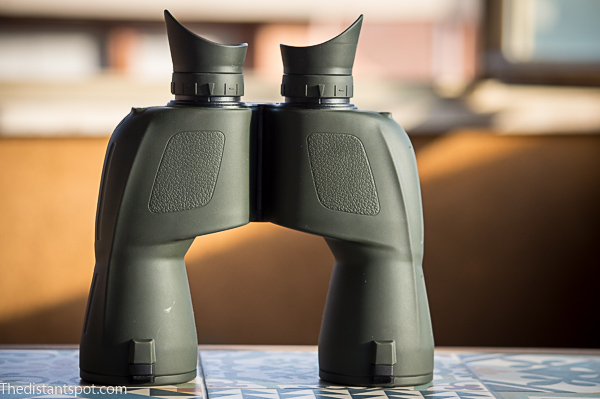
Coma
The management of the coma unfortunately represents one of the weak points of the binoculars. The defect begins to become visible as soon as you move away from the center of the image and, half the distance from the center, it is already more evident than on the edge of the Swarovski.
From this point of view, also the Kowa show superior performance.
Between sharpness reduction, coma, lower brightness and non-sharp edges, the observation of the objects placed right on the edge of the frame, in the Steiner, is seriously compromised.
Tint
The image appears to be mostly neutral in color, with no obvious dominants. The colors are not particularly saturated, but they appear substantially correct. The star Mirphak, a yellow supergiant, appears almost white, while it appears more reddish-yellow in Swarovski and almost red in the Kowa.
Reflections and stray lights
The Steiner Nighthunter 8×56 have an excellent resistance to reflections and stray lights.
The full moon is a very hard subject, but framing it shows less reflections than with the Kowa and the Swarovski, which shows a small luminous dot that shouldn’t be there.
Thanks to porro prisms, framing a light source does not produce any spike.
The Kowa show them in a subtle way, while the Swarovski don’t present any spike unless the light source is placed at the very edge of the frame. This result, which is excellent for roof prism binoculars, involves the application of a series of treatments that have a significant cost which, by using porro prisms, can be saved for to strengthen some different characteristics.
Distortion
The image appears to be characterized by quite some barrel distortion, which causes a swelling of the framed objects towards the observer. Not very annoying in general nor when panning.
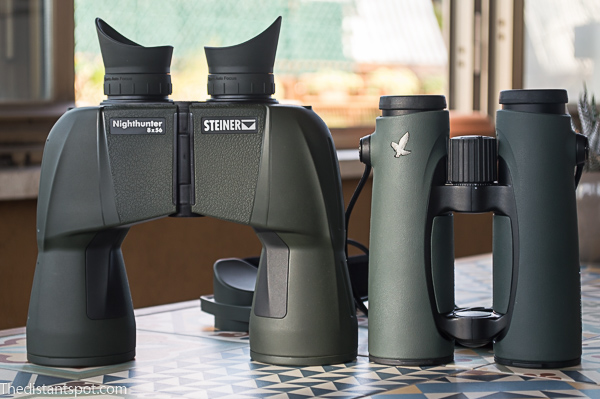
Other aspects
The black border of the framed image does not appear as clear as in other binoculars, on the contrary, from this point of view, the binoculars are quite disappointing.
Moreover, with the eyecups extracted, it is not possible to embrace the entire image. Lowering the eyecups and trying to bring the eyes closer, however, causes some blackouts in the image due to the excessive proximity of the eyes to the eyepieces.
In general, however, the Steiner Nighthunter 8×56 do not require a particularly accurate positioning as is the case, for example, for the Kowa Prominar. Most of the times you can just grab the binoculars and watch, without having to worry about blackouts.
Being a 56mm binocular, which declares a light transmission of more than 96%, I thought the difference in brightness with the other binoculars would be very obvious.
The Kowa, with a diameter of 32mm, are so much smaller that it would have made no sense to use them for a comparison on this parameter.
The Swarovski were darker but, even if this circumstance was very obvious looking at the night sky, it was harder to spot any difference when looking, at dusk, beneath the branches of a big tree.
From my city sky, in any case, the greater brightness of the Steiner did not allow me to distinguish more stars than I saw with the Swarovski. It is possible that the lesser astigmatism of the latter had partially offset the difference in size and light transmission.
I don’t know, however, if this small advantage in terms of brightness is able to compensate for the greater bulk compared to 42 mm binoculars.
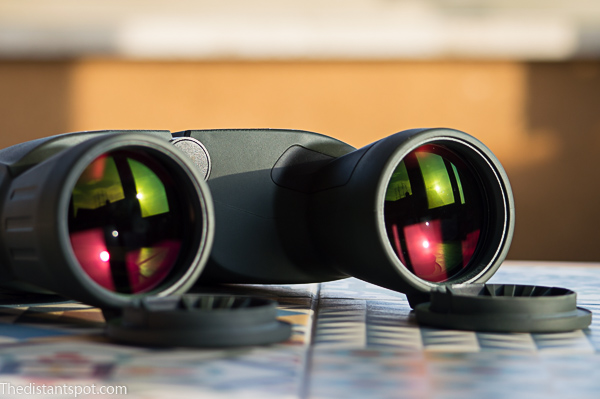
Conclusions
The Steiner Nighthunter 8×56 are certainly made with great care and possess strong optical qualities.
The comparison with the Swarovski showed great differences, but it must always be remembered that, although the Steiner are certainly not cheap, they costs just over a third of the Swarovski.
However, I believe that some defects, such as chromatic aberration and coma, are still too obvious in relation to their price. Although I don’t expect perfection at this price point, at least no defect should be too visibile.
Among the defects that do not concern the optical qualities of the binoculars, the most important are represented by the focusing system and the dimensions. I wrote enough about the first one, and I know that many considerations I made are kind of subjective.
With regard to the second I can say that, although porro prisms allow better results with lower costs, the size of the binoculars is really important. I can’t imagine going around carrying such a big instrument with me. In fact, I purchased it to use it for night-time observations at a fixed location. Even so, however, it seems to me that the difference compared to roof prism binoculars is too much. This is an aspect that everyone interested in this pair of binoculars should carefully consider before purchasing.
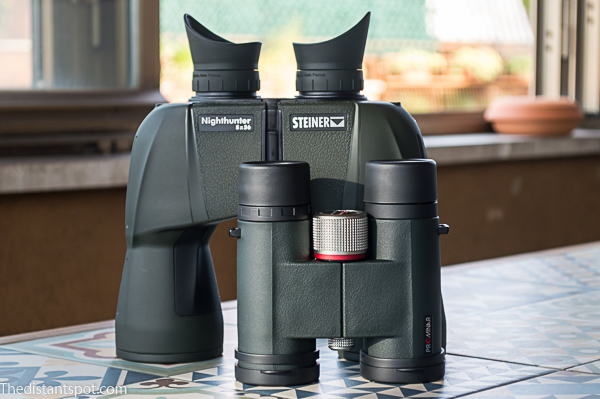
Steiner Nighthunter 8×56
Intro
There is a word that can summarize the essence of the Steiner Nighthunter 8×56: huge.
They are large and solid binoculars, certainly the largest I’ve ever held.
Construction
They are built like a tank and give an incredible sense of solidity even just looking at them.
When you pick them up, you can appreciate the high quality of the rubber coating, which is soft without being sticky and which completely covers the structure of the binoculars.
Two shaped lines run on the tubes and allow the fingers to rest comfortably.
Despite being quite heavy binoculars (just over a kilo) the weight is well distributed and the possibility to hold them with great comfort makes them appear lighter than they are.
The eyecups are shaped so as to accompany the profile of the face and block any light coming from the side.
Although they do their job very well, the shells completely block the circulation of air around the eyes, causing an unpleasant sensation of heat which, at least in summer, makes it very hard to use for more than a few moments.
Anyway the eyecups can be rolled up easily so as not to disturb. I do not know how long the rubber will be able to resist, but it looks very sturdy.

Sports-Auto-Focus
Steiner claims to have a special focus system, called “sports-auto-focus”. In fact, that simply means “individual focus”: each eyepiece must be focused individually by turning a knob that is directly on the eyepiece itself. There is no central focusing knob.
Setting the focus on a subject far away (over 15 meters, I would say) gives a correct focus from there to infinity, without the need for further modifications.
I had never had experience with such a focusing system and I can say, without doubts, that I hate it.
I don’t have perfect eyesight, but I don’t usually wear glasses.
Most binoculars allow you to compensate for the differences in visual acuity between the two eyes so that you can achieve a uniform vision with both. Once you have adjusted the compensation of a single eyepiece, you can focus correctly by simply turning the focusing knob as usual.
This is an uncomfortable and often cumbersome operation, but it is only done once.
In case your visual defect, as it happens for me, is similar in both eyes, it is not even necessary to compensate: with respect to a subject with normal vision, you only need to vary the focus.
Having to individually focus both eyepieces makes this solution impossible.
Each eyepiece must be adjusted independently and, if you are sharing your binoculars with someone else, both focusing knobs must be returned to their initial position before they can see clearly.
At that point, correcting the focus again will require a series of strenuous attempts, unless you have noted the position of the eyepieces that works for you.
The notches on the focusing ring of the Steiner Nighthunter 8×56 can be used for this purpose, but only if it is not too dark to see them. Unfortunately, since these binoculars are specifically suited for use in the dark, it is quite probable that you will find yourself in the last situation.
The single focus offers a number of advantages in terms of resistance and waterproofness of the binoculars, but, unless you have a completely correct vision, these advantages come with a great sacrifice.
The difficulty of reaching a correct focus with both eyes has meant that, during my test, I carefully avoided varying the focus, preferring to observe objects out of focus rather than repeating the procedure.
Furthermore, the knobs are very resistant and adjusting the focus is quite difficult.

Lens cap covers
The lens caps are fantastic. They are certainly the best I’ve ever seen. They are made of thick rubber and sturdy plastic, and they attach directly to the tubes, without the need to held them in place with rubber rings. Once on, they fit perfectly inside the tubes with a closure that is very clean.
Unlike other models, which are also much more expensive (including my Swarovski EL 8.5×42 W B), the joints between the cap and the coupling to the tubes are not made of rubber, like the rest of the caps, but with two strips of fabric that make them much more flexible and, presumably, more durable.
I have always wondered how long it will take before the rubber caps of my Swarovski give up: in this case, I believe that there will be no failure.
Optical qualities
From an optical standpoint, the Steiner Nighthunter 8×56 fail to match their excellent mechanical and constructive performance.
To evaluate these aspects, I compared them with two other binoculars. Since I don’t have another comparable pair of 8×56 binoculars, I compared them with a Swarovski EL 8.5×42 and with a Kowa BD 8×32 Prominar XD, both excellent binoculars in their categories.

Chromatic aberration
The chromatic aberration is very evident already in the center of the field. The swallows, observed in the afternoon against the background of a fairly covered sky, were surrounded by a showy halo: purple in the upper part, green in the lower part. A purple outline also decorated the top of a lamppost exactly in the center of the image.
Even if the chromatic aberration increases towards the edge, it never becomes much more evident than it is already in the center of the field.
Sharpness
The sharpness is excellent in the center of the field, but it begins to fall as soon as you move: even a minimum movement produces a drop in sharpness that, if by day, framing a panorama, can pass unnoticed, is evident at night, observing the moon.
However, up to 50% from the edge the sharpness remains good, then it starts to deteriorate more markedly but, up to 75/80%, it still remains acceptable and, even on the edge, it doesn’t become terrible. The sharpness seems to get worse more quickly by moving the object framed along the vertical axis, while staying higher in the case of horizontal movement.
The three binoculars are all very sharp: the Kowa are almost like the other two, while Swarovski and Steiner are very close.
To be honest, I must admit that the Steiner are more contrasted, either in the observation of the moon, in which you can perceive a greater chromatic separation between the seas and the other lighter areas, and in the observation of a group of trees in the distance: the details of their barks seem to stand out more.
Astigmatism
The binoculars have a very low astigmatism, similar to that of the Kowa and not far from the Swarovski, provided, however, that the focus is optimal.

Coma
The management of the coma unfortunately represents one of the weak points of the binoculars. The defect begins to become visible as soon as you move away from the center of the image and, half the distance from the center, it is already more evident than on the edge of the Swarovski.
From this point of view, also the Kowa show superior performance.
Between sharpness reduction, coma, lower brightness and non-sharp edges, the observation of the objects placed right on the edge of the frame, in the Steiner, is seriously compromised.
Tint
The image appears to be mostly neutral in color, with no obvious dominants. The colors are not particularly saturated, but they appear substantially correct. The star Mirphak, a yellow supergiant, appears almost white, while it appears more reddish-yellow in Swarovski and almost red in the Kowa.
Reflections and stray lights
The Steiner Nighthunter 8×56 have an excellent resistance to reflections and stray lights.
The full moon is a very hard subject, but framing it shows less reflections than with the Kowa and the Swarovski, which shows a small luminous dot that shouldn’t be there.
Thanks to porro prisms, framing a light source does not produce any spike.
The Kowa show them in a subtle way, while the Swarovski don’t present any spike unless the light source is placed at the very edge of the frame. This result, which is excellent for roof prism binoculars, involves the application of a series of treatments that have a significant cost which, by using porro prisms, can be saved for to strengthen some different characteristics.
Distortion
The image appears to be characterized by quite some barrel distortion, which causes a swelling of the framed objects towards the observer. Not very annoying in general nor when panning.

Other aspects
The black border of the framed image does not appear as clear as in other binoculars, on the contrary, from this point of view, the binoculars are quite disappointing.
Moreover, with the eyecups extracted, it is not possible to embrace the entire image. Lowering the eyecups and trying to bring the eyes closer, however, causes some blackouts in the image due to the excessive proximity of the eyes to the eyepieces.
In general, however, the Steiner Nighthunter 8×56 do not require a particularly accurate positioning as is the case, for example, for the Kowa Prominar. Most of the times you can just grab the binoculars and watch, without having to worry about blackouts.
Being a 56mm binocular, which declares a light transmission of more than 96%, I thought the difference in brightness with the other binoculars would be very obvious.
The Kowa, with a diameter of 32mm, are so much smaller that it would have made no sense to use them for a comparison on this parameter.
The Swarovski were darker but, even if this circumstance was very obvious looking at the night sky, it was harder to spot any difference when looking, at dusk, beneath the branches of a big tree.
From my city sky, in any case, the greater brightness of the Steiner did not allow me to distinguish more stars than I saw with the Swarovski. It is possible that the lesser astigmatism of the latter had partially offset the difference in size and light transmission.
I don’t know, however, if this small advantage in terms of brightness is able to compensate for the greater bulk compared to 42 mm binoculars.

Conclusions
The Steiner Nighthunter 8×56 are certainly made with great care and possess strong optical qualities.
The comparison with the Swarovski showed great differences, but it must always be remembered that, although the Steiner are certainly not cheap, they costs just over a third of the Swarovski.
However, I believe that some defects, such as chromatic aberration and coma, are still too obvious in relation to their price. Although I don’t expect perfection at this price point, at least no defect should be too visibile.
Among the defects that do not concern the optical qualities of the binoculars, the most important are represented by the focusing system and the dimensions. I wrote enough about the first one, and I know that many considerations I made are kind of subjective.
With regard to the second I can say that, although porro prisms allow better results with lower costs, the size of the binoculars is really important. I can’t imagine going around carrying such a big instrument with me. In fact, I purchased it to use it for night-time observations at a fixed location. Even so, however, it seems to me that the difference compared to roof prism binoculars is too much. This is an aspect that everyone interested in this pair of binoculars should carefully consider before purchasing.



